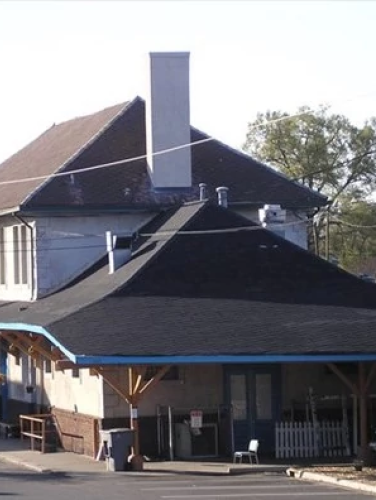
Seaboard Air Line Railroad Passenger Terminal
(ca. 1896)
The Seaboard Air Line Railroad Passenger Terminal is Charlotte’s only surviving nineteenth-century railroad passenger terminal.
945 N College St, Charlotte, NC 28206
The Seaboard Air Line Railroad Passenger Terminal is actually the second railroad passenger terminal to be constructed on this site. The first – a narrow two-story structure with a tin roof – was built in 1858 by the Wilmington, Charlotte and Rutherfordton Railroad Company, and served as the eastern terminus of a thirty-one-mile line from Charlotte to Lincolnton that was completed by April 1861. In May 1873, the Carolina Central Railroad Company acquired the right of way to that line and made it part of a continuous trans-North Carolina track from Wilmington to Rutherfordton. With the late 1874 completion of that route, the terminal now provided access to Charlotte’s major east-west passenger line. In 1893, the Carolina Central joined with several other railroads to form the Seaboard Air Line.
Property Quick Links
That original passenger terminal was destroyed by fire in February 1895. As a temporary measure, the Seaboard Air Line enclosed the remaining passenger sheds for use as an interim facility, but the company planned to build a new and more imposing edifice. In July 1895, the local press announced Charles Christian Hook as the architect of the new terminal.
C. C. Hook (1870-1938) was the first architect to live in Charlotte. The graduate of Washington University in St. Louis, Missouri, originally moved to Charlotte in 1891 to teach mechanical drawing in the Charlotte Graded School. He soon became Charlotte’s first full-time professional architect, designing houses for Edward Dilworth Latta (1851-1925) in Dilworth, the city’s first streetcar suburb. Hook designed some 800 to 1,000 homes and buildings across the Carolinas, including Charlotte’s U.S. Post Office and Courthouse, Charlotte City Hall, the Carolina Theater, Myers Park Elementary School, three local fire stations, and several buildings on college campuses across North Carolina (including the Chapel Hill and Greensboro campuses of the University of North Carolina, Davidson College, and N.C. State, Duke, and Queens Universities). Hook also designed James B. Duke’s Myers Park mansion and the William Henry Belk House in Elizabeth.
Local contractor W. C. Williams began construction of the new passenger terminal in December 1895, and the Seaboard Air Line opened the terminal in June 1896. It was from this two-story brick structure that approximately 200 local men departed for military service in the Spanish American War. Ultimately, the advent of the “automobile era” eroded the popularity of trains as a means of intercity transportation. The last train from Charlotte to Rutherfordton departed in December 1950. The final train traveling eastward left the station in November 1958. Thereafter, the Seaboard Air Line Railroad Passenger Terminal served as a yard office for the Seaboard Air Line (later Seaboard Coast Line Railroad). In 1993, the property was acquired by the Charlotte Center for Urban Ministry and repurposed as a service center to support the city’s homeless population.
The Seaboard Air Line Railroad Passenger Terminal remains as Charlotte’s only surviving pre-1900 railroad passenger terminal.

